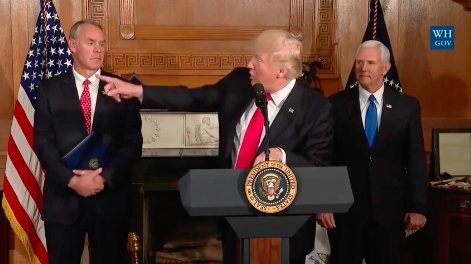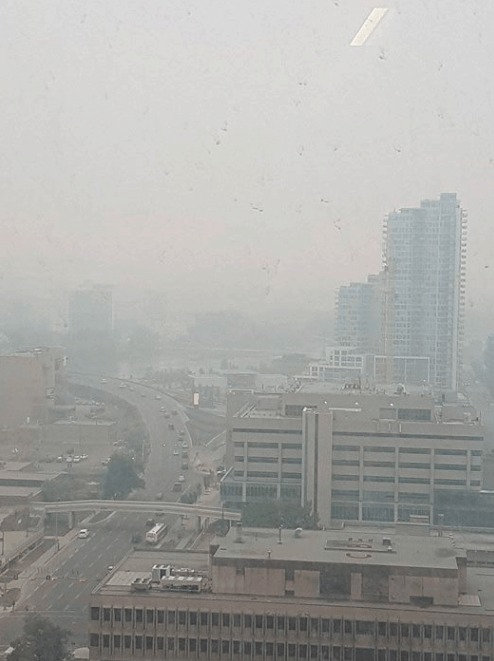
Official Transcript from Trump’s Cabinet Meeting (08/16/18)
PRESIDENT TRUMP: I would like to ask Ryan Zinke, Secretary of the Interior, who I actually watched this morning, as he was giving a rundown on the horrible fires that are taking place mostly in California, and I thought what he said was so true and actually rather incredible. People don’t hear it, they don’t hear it like it is. There are things you can do about those fires before they start, and you wouldn’t have nearly the damage and the problems. We are spending a fortune in California because of poor maintenance and because frankly, they are sending a lot of water out to the pacific to protect the smelt and by the way, it’s not working. The smelt is not doing well. But we are sending millions and millions of gallons right out into the Pacific Ocean. Beautiful, clean water coming up from the north or coming down from the north, and I thought Ryan was great this morning so before we start on a couple of other things we will be discussing today, including very importantly, schools and education, I would ask you to give maybe a little recap of what you said this morning on television.
INTERIOR SECRETARY RYAN ZINKE: Thank you, Mr. President. First, our firefighters, 30,000 of them, are doing spectacular things. They have had six deaths related and we forget that firefighters, while they are on the front lines, their homes and families are in jeopardy, and our hearts and prayers need to be with our front line firefighters that are out there every day. It is a matter of gross mismanagement. There is no question. The density of our forest is historical. If you don’t believe me, believe your own eyes. Go out and take a look at our forest. Take a drive out there and look at the dead and dying timber. It’s been in gross mismanagement for decades but we are burning our forests, destroying our habitat and destroying our communities and neighborhoods by these catastrophic fires of 200,000, 300,000 acres. Thus far, there’s 5.7 million acres of our public lands that have been destroyed at a cost of about $3 billion this fiscal year. Americans deserve to go out and recreate rather than evacuate, so we went out, Secretary Perdue and I went out to California. We are committed to reestablishing sound science, best practices for the greatest good for all of us. But sound, active management, Mr. President, is the path that you have laid, it’s clear. This is unacceptable that year after year, we are watching our forests burn, our habitat destroyed and our communities devastated, and it is absolutely preventable, and public lands are for everybody to enjoy and not just held hostage by these special interest groups. Thank you, Mr. President.
PRESIDENT TRUMP: Ryan was saying it’s not a global warming thing. It’s a management situation and one of the elements that he talked about was the fact that we have fallen trees and instead of removing those fallen trees, which get to be extremely combustible, instead of removing them, gently removing them, beautifully removing them, we leave them to burn and actually, in many cases, catch fire much easier than a healthy tree, a healthy growing tree. Could you just discuss that for a second?
SECRETARY ZINKE: Well, Mr. President, we import lumber in this country, yet there are billions of board feet that are on the forest floor rotting. Rotting. And whether you’re a global warmest advocate or denier, it doesn’t make a difference when you have rotting timber, when housing prices are going up, when a lot of Americans are right at the border of affording a house, yet we are wasting billions of board feet for not being able to bring them to a local lumber mill. It is unconscionable we would do that to our citizens. Mr. President, we are actively engaged. Secretary Perdue and I, we went out to California- we are joined at the hip to make sure we actively manage our forests, remove the dead and dying timber, replant diversity of species and on the salvage operations, 5.7 million acres. A lot of that can be salvaged if we get to it in the first year. We are going to do it, Mr. President.
PRESIDENT TRUMP: Just to add, just to conclude, especially when Canada is charging us a lot of money to bring their timber down into our country, so ridiculous. [NOTE: In April 2017 President Trump placed a 20.83% tariff on Canadian lumber. – mk] Here we have it. We’re not even talking about cutting down trees. Which in certain areas, we can’t do. We are talking about trees lying on the floor, creating a tremendous hazard and a tremendous fire hazard, and death trap. So, I thought they were great points. Thank you very much, Ryan. Appreciate it.


